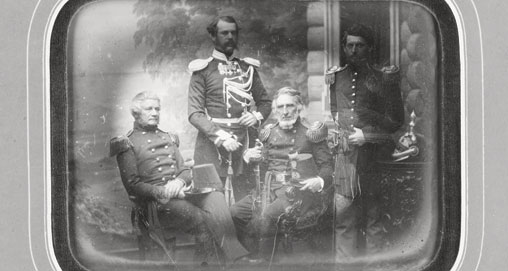
For soldiers, to be ordained into the Ordnance Dept. or Corps of Engineers before the Civil War was a glorious honor. One became a member of a hand-picked intellectual aristocracy crammed with the country’s most proficient masters of scientific and technical detail. Rank, power and privileges showered down upon them. Believed exclusively suitable for this elite were West Pointers, and not just “any” West Pointers either, but only those graduating at the top of their class.
Nevertheless, few of these technocrats achieved the renown of the great battlefield commanders. (The ones who did, such as Robert E. Lee—who ranked second in his class and joined the Engineers—gained fame by transferring to the cavalry or infantry.) Among these obscure individuals was Maj. Alfred Mordecai of Ordnance. Yet while fame continues to elude him to this day, Mordecai’s influence is still felt on American shooting and soldiering.
The Mordecais were a Jewish family long settled in America: Alfred’s grandfather signed the anti-British Non-Importation Agreement of 1765, and his father served as a sergeant during the War of Independence. Alfred himself, born in 1804, was a scholarly boy fascinated by the campaigns of Napoleon, and in 1819 Mordecai achieved his dream: a West Point cadetship.
Though Mordecai hardly enjoyed “the stiffness caused in my left arm by carrying for two hours a day the unaccustomed weight of the heavy old line musket” during drill at the Academy, he excelled at calculus and relished his courses in “Civil Engineering & the Principles of Machines.”
Graduating first in his class, it was his right to select his field of specialty. Mordecai, like the other stars, plumped for the Corps of Engineers. After his promotion to captain in 1832, he joined the Ordnance elite and stayed there for the following 29 years. Distinguishing himself from the outset, Mordecai took command of the important Washington arsenal in 1833, then Frankford in 1836, then Washington again, and finally Watervliet in 1857. In 1854 he was promoted to major. In the 1840s alone, sealing his reputation as America’s finest ballistician, he published the influential tracts, “The Ordnance Manual,” “Report of Experiments on Gunpowder,” “Second Report of Experiments on Gunpowder,” and “Artillery for the United States Land Service.”
But Mordecai’s most important work was done at the behest of Secretary of War Jefferson Davis in 1855. Davis, who would later become president of the Confederate States of America, was concerned that the United States was beginning to lag in arms technology. “Though our arms have heretofore been considered the best in use,” he reported, “recent inventions in Europe have produced changes in small arms, which are now being used in war.” The “war” he referred to was the Crimean, then being fought between the Russian Empire and an alliance of Britain, France, and Turkey.
He dispatched Mordecai and two colleagues (Maj. Richard Delafield and Capt. George B. McClellan) as part of a commission to survey the state of European armaments and discern whether there was any truth to his suspicions.
Davis chose only the best for his roving investigative team: Delafield (also first in his class at West Point) was an Engineer, and McClellan, later an undistinguished commander of the Union forces but then regarded as highly promising, graduated second in his class and was a former Engineer. And then there was Mordecai. As the leading American soldier-technologist of his time, Mordecai’s brief from Davis was to explore the “practical advantages and disadvantages attending the use of the various kinds of rifled arms” in European service so that the war secretary could assess American procurement policy.
The commission steamed from Boston on April 11, 1855, its first landfall being Britain. France and Prussia were next, followed by Poland and Russia. After returning to Berlin, they traveled through Austria and arrived in Constantinople on Sept. 16. Through the next several months, the trio made their way back across Europe and arrived home almost exactly one year after departing.
On their return, the commissioners began compiling their separate reports, Mordecai submitting his in April 1858. His “Military Commission to Europe” in 1855 and 1856 is a landmark in military literature. Its most striking aspect is Mordecai’s fascination with the minute variations between the arms issued by each nation to its soldiers, and their almost infinite complexity and splendor. To him, the differences and degrees of deviation—imperceptible to the uninitiated—between, say, the Hanoverian seven-grooved rifle-musket, the Hanoverian eight-grooved rifle and the English two-grooved rifle, were endless forms of the most beautiful and wonderful kind.
His comprehensive treatment of European military science is also a masterpiece of unbiased scholarship. Mordecai carefully weighs the pros and cons of each system, compiles intricate charts to demonstrate their degrees of differences and similarities, traces every historical variation in bullet design back to its original source, and agglomerates dense tables of barrel lengths, angles of elevation and ranges.
Most interestingly, the worldview of the antebellum soldier is perfectly preserved in Mordecai’s report. Take, for instance, his curious blind-spot toward repeaters and breechloaders.
Of repeaters so little is said that it appears as if Mordecai hoped that studiously ignoring them would make them go away. He has no time for the rapid-firing products of such new manufacturers as Spencer and Colt, let alone the truly revolutionary all-in-one metallic cartridges being developed by Smith & Wesson that enabled them to work. From Ordnance’s point of view, repeaters were underpowered, extravagantly wasteful of ammunition and contributed to sloppy shooting.
As for breechloaders, Mordecai mentions them here and there, but really, he thought them merely faddish. About the Prussian “needle-gun” he restricts himself to the unenthusiastic comment, “its complicated structure, and other objections, seem to have prevented it from finding favor in any other country.” This would be the very same gun that would soon propel Prussia to devastating mastery over France and Austria in the 1860s—not so long after Mordecai wrote those dismissive words.
Mordecai makes other similar remarks. For instance, referring to the breechloading rifle being tested by the French imperial guards, he judges that their arms might work tolerably well “under cover of a roof; but it would not seem to be adapted to use in the ordinary vicissitudes of military service.” Mordecai was even unwilling to compare the American-made, breechloading Sharps rifle against any European design, despite the Sharps working rather better than “tolerably well” in the outdoors. (After all, the grizzled guards for the U.S. Mail coaches bumping over the hazardous trail between Santa Fe, El Paso and San Antonio swore by them.) Ultimately, Mordecai concluded that although one or two of the Great Powers were experimenting with breechloading rifles, nevertheless “the great body of the infantry of all the armies engaged used the ordinary [smoothbore] musket.”
In short, in the years before the Civil War, Ordnance’s collective wisdom was that breechloaders, repeating or otherwise, were endemically flawed; the technology was an evolutionary dead end. Consequently, all efforts should be directed toward developing the best possible muzzleloading single-shot rifle.
This is not to say that the Department was comprised of last-ditch reactionaries dedicated to turning the clock back to, say, the year 1800. The muzzleloading products made by its Springfield and Harpers Ferry factories from the 1850s onward integrated an advanced French technology known as the Minié bullet, which was a great leap forward in projectile design. The cylindro-conoidal Minié permitted far greater range and accuracy than its centuries-old predecessor technology: spherical lead balls propelled by combusting blackpowder.
The differences in performance were striking. In a competition between Minié rifles and smoothbore muskets, 20 men fired 10 shots with each weapon, or 200 rounds per gun, at a target 6-feet high and 20-feet across meant to represent an enemy unit. At 100 yards, 149 musket shots hit (74.5 percent) compared with 189 Minié shots (94.5 percent). But at 400 yards, just nine (4.5 percent) musket shots found their mark; the Minié rifle hit 105 times (52.5 percent).
So it was that Mordecai and his fellow Ordnance men believed they were developing a rifle that was more innovative than any untried breechloader or repeater, and that far surpassed the “ordinary muskets” being issued to European soldiers. To Davis’ surprise, then, Mordecai did not report on what Americans could learn from the Europeans, but actually confirmed that they were already ahead of them!
The rifle in question was the .58-cal. U.S. Model 1855 rifle-musket, a design that marked the end of army production of smoothbores. Along with its Minié mechanism, it came equipped with a state-of-the-art Maynard priming system that used a roll of percussion caps to ignite the powder.
When the commissioners departed for Europe in April 1855, the new rifle was still awaiting approval from Davis (given on July 5), but in 1857 it went into production at Springfield and, two years later, at Harpers Ferry. Though the South enjoyed a windfall of Model 1855 machinery after the capture of Harpers Ferry, in the North the model was manufactured until only mid-1861, when it was replaced by Ordnance’s newest upgrade, the Model 1861. Roughly 750,000 were made, to which must be added more than half a million Models 1863 and 1864 (which were enhanced versions).
Given that only around 60,000 Model 1855s were produced, the arm may not have enjoyed the success of its replacements—partly because it was not quite as excellent a piece as advertised—but as Mordecai’s pride and joy it served as the patriarch of a family of army rifles whose influence would last at least until the advent of the M16 in the 1960s.
The critical importance of the Model 1855 dynasty lay in Mordecai’s fascination with range and accuracy—attributes that he could precisely measure, quantify, standardize, classify and compare. What mattered in a rifle, he believed, was its ability to allow a soldier to shoot his target at the longest distance possible and with the bare minimum of ammunition. To Mordecai, marksmanship was all, and in this he was adapting the historical American talent for fine shooting to the scientifically minded Victorian era.
Marksmanship was key because Mordecai was confident that in future wars combatants would need to be at least 400 yards apart owing to the introduction of the devastating Minié bullet. Human conflict was to be a long-range affair, for which neither breechloaders (that lacked range owing to gas-leakage) and repeaters (that lacked accuracy owing to their rapid firing) were suitable.
In this estimation he was disastrously wrong. In fact, as a sustained analysis of the Civil War’s battles, skirmishes and actions reveals, the average distance between the two sides during a firefight was a mere 127 yards.
Amid the mud, roar and terror of the front, Mordecai’s dense computations and rational assumptions were rendered meaningless. The future was seemingly mortgaged to firepower, exemplified by soldiers’ close-range use of buck n’ ball (a .69-cal. ball and three buckshot) and the post-war rise of the breechloading repeater.
Nevertheless, Mordecai got one big thing absolutely right: No matter with which arm, sound shooting—honed by practice, personal self-discipline, mastery over one’s firearm and coolness under pressure—was what distinguished soldiers from savages, Americans from suborned troops, professional warriors from raw conscripts.
Mordecai himself stood aside from these developments. After the first guns were fired, as he put it, “in that Calamitous Conflict,” Mordecai resigned his commission “for reasons peculiar to myself.” His “peculiar” reasons were that as a moderate, Southern-born Democrat and an individual of self-confessedly robust “conservative opinions,” Mordecai grieved for the North’s abolitionist “interference” in affairs below the Mason-Dixon Line, but he had “no sympathy” with slavery and he was a good and faithful servant of the federal government.
Mordecai’s loyalties were thus cruelly divided, and his only means of reconciling them was to avoid the company of “fanatics, North or South.” Though as the country’s leading ballistician Mordecai was offered high-ranking commissions by both the Confederacy and the Union, he refused them so that he would never be forced to choose a side. So it was that on May 2, 1861, the 57-year-old Mordecai deliberately sacrificed his hopes of higher rank by departing his beloved Ordnance Dept. (though not before recommending to Davis that his deputy Josiah Gorgas serve as Ordnance chief). He and his family moved to Philadelphia to wait out the war. After Appomattox, Mordecai joined the Vera Cruz and Mexican Railway as a senior engineer, but later returned to Philadelphia as secretary and treasurer of the Pennsylvania Railroad, dying at the age of 85 in 1887.
By that time, he at least had enjoyed the satisfaction of seeing the United States Army, hoping to avoid another bloodbath like the Civil War, adopt the strictest principles and practices of marksmanship, a policy that turned its men into the most lethal soldiers, shot for shot, in the world.
And so his ghost lived on. By preserving marksmanship as the quintessential American trait—a belief adopted by the nascent NRA from the 1870s onward—he can be counted as the spiritual father of such fine-shooting legends as the Springfield Model 1903 and the M1 Garand. It was a proud legacy for this unfairly obscure weaponry wizard.
Alexander Rose is the author of “American Rifle: A Biography” and “Washington’s Spies: A History of America’s First Spy Ring.”





































